Pedestrian Emotion Perception in Urban Built Environments Based on Virtual Reality Technology: A Comparative Review of Chinese- and English-Language Literature
Abstract
1. Introduction
2. Methods and Data
2.1. Research Framework
2.2. Methods
2.3. Data Source
3. Analysis of Chinese-Language and English-Language Research Status
3.1. Temporal Distribution of Publications
3.2. Major Research Contributors and Collaboration Networks
3.3. Research Hotspots and Development Trends
3.3.1. Research Hotspots
3.3.2. Development Trends
3.4. Similarities and Differences Between Chinese-Language and English-Language Literature
4. Discussion
4.1. Mechanism Linking Built Environment and Emotional Feedback
4.2. Spatial Intervention Design Strategies
4.3. Macro-Level Policy Development
4.4. Applications and Prospects of Virtual Reality Technology
5. Conclusions and Future Envision
Author Contributions
Funding
Data Availability Statement
Conflicts of Interest
References
- Fletcher, D.; Sarkar, M. Psychological resilience. Eur. Psychol. 2013, 18, 12–23. [Google Scholar] [CrossRef]
- Li, Z.; Huang, X.; White, M. Effects of the visual character of transitional spaces on human stress recovery in a virtual reality environment. Int. J. Environ. Res. Public Health 2022, 19, 13143. [Google Scholar] [CrossRef] [PubMed]
- Jia, J.; Zhang, X.Q.; Zhang, W.Z.; Chen, L. Impact of perceived quality of urban human settlements on subjective well-being of the employed population. Geogr. Res. 2024, 43, 2460–2478. [Google Scholar]
- Dong, H.X.; Gao, X. The impact of street planting space on walking pleasure. Landsc. Archit. 2023, 30, 54–62. [Google Scholar]
- Kaplan, S.; Talbot, J.F. Psychological benefits of a wilderness experience. In Human Behavior and Environment: Advances in Theory and Research: Behavior and the Natural Environment; Altman, I., Wohlwill, J.F., Eds.; Plenum Press: New York, NY, USA, 1983; pp. 163–203. [Google Scholar]
- Lynch, K. The Image of the City; MIT Press: Cambridge, MA, USA, 1964. [Google Scholar]
- Larsen, R.J.; Fredrickson, B.L. Measurement issues in emotion research. In Well-Being: The Foundations of Hedonic Psychology; Russell Sage Foundation: New York, NY, USA, 1999; Volume 40, p. 60. [Google Scholar]
- Zeman, J.; Klimes-Dougan, B.; Cassano, M.; Adrian, M. Measurement issues in emotion research with children and adolescents. Clin. Psychol. Sci. Pract. 2007, 14, 377. [Google Scholar] [CrossRef]
- Korpal, P.; Jankowiak, K. Physiological and self-report measures in emotion studies: Methodological considerations. Pol. Psychol. Bull. 2018, 49, 475–481. [Google Scholar] [CrossRef]
- Higuera-Trujillo, J.L.; Llinares, C.; Macagno, E. The cognitive-emotional design and study of architectural space: A scoping review of neuroarchitecture and its precursor approaches. Sensors 2021, 21, 2193. [Google Scholar] [CrossRef]
- Winkielman, P.; Berridge, K.C. Unconscious emotion. Curr. Dir. Psychol. Sci. 2004, 13, 120–123. [Google Scholar] [CrossRef]
- Lin, J.J.; Duh, H.B.; Parker, D.E.; Abi-Rached, H.; Furness, T.A. Effects of field of view on presence, enjoyment, memory, and simulator sickness in a virtual environment. In Proceedings of the IEEE Virtual Reality 2002, Orlando, FL, USA, 7 August 2002; pp. 164–171. [Google Scholar]
- Wu, X.; Fan, L.H. A review of pedestrian behavior in urban street environments using virtual reality technology. Urban Dev. Stud. 2019, 26, 103–108. [Google Scholar]
- He, S.; Lin, G.C.S. Producing and consuming China’s new urban space: State, market and society. Urban Stud. 2015, 52, 2757–2773. [Google Scholar] [CrossRef]
- Hu, M.; Roberts, J. Built environment evaluation in virtual reality environments—A cognitive neuroscience approach. Urban Sci. 2020, 4, 48. [Google Scholar] [CrossRef]
- He, J.; Zhao, R.; Zhang, H.S. Visualization and bibliometric analysis of knowledge graphs. Comput. Sci. 2024, 51, 13–22. [Google Scholar]
- Chen, C. CiteSpace: A Practical Guide for Mapping Scientific Literature; Nova Science Publishers: Hauppauge, NY, USA, 2016. [Google Scholar]
- Nelson, C.; Watt, S. Academic Keywords: A Devil’s Dictionary for Higher Education; Routledge: Oxfordshire, UK, 2002. [Google Scholar]
- Wang, M.; Chai, L. Three new bibliometric indicators/approaches derived from keyword analysis. Scientometrics 2018, 116, 721–750. [Google Scholar] [CrossRef]
- Lee, J.; Wu, G.; Jung, H. Deep Learning Document Analysis System Based on Keyword Frequency and Section Centrality Analysis. J. Inf. Commun. Converg. Eng. 2021, 19, 48. [Google Scholar]
- Xu, L.Q.; Meng, R.X.; Huang, S.Q.; Chen, Z. Healing-oriented street design: An exploration based on VR experiments. Urban Plan. Int. 2019, 34, 38–45. [Google Scholar] [CrossRef]
- Bower, I.; Tucker, R.; Enticott, P.G. Impact of built environment design on emotion measured via neurophysiological correlates and subjective indicators: A systematic review. J. Environ. Psychol. 2019, 66, 101344. [Google Scholar] [CrossRef]
- Hao, S.M.; Li, J.H. A virtual healing interface for emotional support among older adults. World Archit. 2023, 7, 26–31. [Google Scholar]
- Wang, Y.; Lu, S.; Xu, M.; Zhang, Y.; Xu, F. What influences stress reduction in urban forests: Environment types or personality traits? Urban For. Urban Green. 2024, 92, 128187. [Google Scholar] [CrossRef]
- Leng, H.; Yan, T.J.; Yuan, Q. Research progress and implications of the mental health effects of blue-green spaces. Urban Plan. Int. 2022, 37, 34–43+52. [Google Scholar] [CrossRef]
- Van den Bosch, M. Impacts of urban forests on physical and mental health and wellbeing. In Routledge Handbook of Urban Forestry; Routledge: Oxfordshire, UK, 2017; pp. 82–95. [Google Scholar]
- Abu Hasan, R.; Yusoff, M.S.B.; Tang, T.B.; Hafeez, Y.; Mustafa, M.C.; Dzainudin, M.; Bacotang, J.; Al-Saggaf, U.M.; Ali, S.S.A. Resilience-building for mental health among early childhood educators: A systematic review and pilot study toward an EEG-VR intervention. Int. J. Environ. Res. Public Health 2022, 19, 4413. [Google Scholar] [CrossRef]
- Petrescu, L.; Petrescu, C.; Mitruț, O.; Moise, G.; Moldoveanu, A.; Moldoveanu, F.; Leordeanu, M. Integrating biosignals measurement in virtual reality environments for anxiety detection. Sensors 2020, 20, 7088. [Google Scholar] [CrossRef] [PubMed]
- Yang, S.; Dane, G.; van den Berg, P.; Arentze, T. Influences of cognitive appraisal and individual characteristics on citizens’ perception and emotion in urban environments: Model development and VR experiment. J. Environ. Psychol. 2024, 96, 102309. [Google Scholar] [CrossRef]
- Parreno, C. Boredom, Architecture, and Spatial Experience; Bloomsbury Publishing: London, UK, 2021. [Google Scholar]
- Russell, J.A.; Pratt, G. A description of the affective quality attributed to environments. J. Personal. Soc. Psychol. 1980, 38, 311. [Google Scholar] [CrossRef]
- Banaei, M.; Hatami, J.; Yazdanfar, A.; Gramann, K. Walking through architectural spaces: The impact of interior forms on human brain dynamics. Front. Hum. Neurosci. 2017, 11, 477. [Google Scholar] [CrossRef]
- Schreuder, E.; Van Erp, J.; Toet, A.; Kallen, V.L. Emotional responses to multisensory environmental stimuli: A conceptual framework and literature review. SAGE Open 2016, 6, 2158244016630591. [Google Scholar] [CrossRef]
- Lu, S.M. Recognition and evaluation of regional architectural features based on visual cognition: A case study of ethnic minority dwellings in Nujiang region. New Archit. 2021, 1, 110–115. [Google Scholar]
- Tabbaa, L.; Searle, R.; Bafti, S.M.; Hossain, M.M.; Intarasisrisawat, J.; Glancy, M.; Ang, C.S. Vreed: Virtual reality emotion recognition dataset using eye tracking and physiological measures. Proc. ACM Interact. Mob. Wearable Ubiquitous Technol. 2021, 5, 178. [Google Scholar] [CrossRef]
- Kjellgren, A.; Buhrkall, H. A comparison of the restorative effect of a natural environment with that of a simulated natural environment. J. Environ. Psychol. 2010, 30, 464–472. [Google Scholar] [CrossRef]
- Wang, Z.; Li, Y.; An, J.; Dong, W.; Li, H.; Ma, H.; Wang, J.; Wu, J.; Jiang, T.; Wang, G. Effects of restorative environments and presence on anxiety and depression using interactive VR scenarios. Int. J. Environ. Res. Public Health 2022, 19, 7878. [Google Scholar] [CrossRef]
- Robert McComb, J.J.; Tacon, A.; Randolph, P.; Caldera, Y. A pilot study to examine the effects of a mindfulness-based stress-reduction and relaxation program on levels of stress hormones, physical functioning, and submaximal exercise responses. J. Altern. Complement. Med. 2004, 10, 819–827. [Google Scholar] [CrossRef]
- Salgado-Pineda, P.; Ferrer, M.; Calvo, N.; Costa, X.; Ribas, N.; Lara, B.; Tarragona, B.; Fuentes-Claramonte, P.; Salvador, R.; Pomarol-Clotet, E. Brain functional abnormalities in drug-treated and drug-naïve adolescents with borderline personality disorder: Evidence for default mode network dysfunction. J. Psychiatr. Res. 2023, 161, 40–47. [Google Scholar] [CrossRef]
- Watanabe, K.; Funahashi, S. Neural mechanisms of dual-task interference and cognitive capacity limitation in the prefrontal cortex. Nat. Neurosci. 2014, 17, 601–611. [Google Scholar] [CrossRef] [PubMed]
- Zhang, Y.; Jing, X.; Liu, C.; Zhang, Y.; Jing, X.; Liu, C.; Sun, Y.; Wang, W.; Gao, W. Restorative benefits of classroom windows: Effect of window-to-wall ratio on task load and learning performance using VR. Int. J. Low-Carbon Technol. 2024, 19, 1491–1500. [Google Scholar] [CrossRef]
- Nallaperuma, K.; Septianto, F.; Bandyopadhyay, A. Mixed emotional appeal enhances advertising effectiveness of pro-environmental luxury brands: The mediating role of cognitive flexibility. Asia Pac. J. Mark. Logist. 2022, 34, 175–189. [Google Scholar] [CrossRef]
- Mauri, M.; Rancati, G.; Riva, G.; Gaggioli, A. Comparing immersive and non-immersive real estate experiences on behavioral intentions. Comput. Hum. Behav. 2024, 150, 107996. [Google Scholar] [CrossRef]
- Hirst, W.; Yamashiro, J.K.; Coman, A. Collective memory from a psychological perspective. Trends Cogn. Sci. 2018, 22, 438–451. [Google Scholar] [CrossRef]
- Zhang, Z.; Xu, L.Q. Emotional atmosphere in virtual reality: Evidence-based exploration of healing and vibrant street micro-renewal design. Landsc. Archit. 2024, 31, 53–60. [Google Scholar] [CrossRef]
- Stanitsa, A. Evidence-Based Strategies for Urban Design Decision-Making: The case of Pedestrian Movement Behavior. Ph.D. Thesis, Cranfield University, Bedfordshire, UK, 2022. [Google Scholar]
- Yildirim, M.; Globa, A.; Gocer, O.; Brambilla, A. Designing Multisensory User Experiences in Immersive VR Systems: A Mixed-Method Approach for Human–Built Environment Interactions. 2024. Available online: https://ssrn.com/abstract=4979287 (accessed on 21 April 2025).
- Medalia, A.; Saperstein, A.M.; Hansen, M.C.; Lee, S. Personalised treatment for cognitive dysfunction in individuals with schizophrenia spectrum disorders. Neuropsychol. Rehabil. 2018, 28, 602–613. [Google Scholar] [CrossRef]
- Zhang, Z.; Zhuo, K.; Wei, W.; Li, F.; Yin, J.; Xu, L. Emotional responses to visual patterns of urban streets: Evidence from physiological and subjective indicators. Int. J. Environ. Res. Public Health 2021, 18, 9677. [Google Scholar] [CrossRef]
- Makanadar, A. Neuro-adaptive architecture: Buildings and city design that respond to human emotions and cognitive states. Res. Glob. 2024, 8, 100222. [Google Scholar] [CrossRef]
- Song, H.; Zhen, F.; Xu, H.X. Urban spatial environment design based on physical activity and psychological perception. Mod. Urban Res. 2023, 12, 45–51. [Google Scholar]
- Yao, G.; Yuan, T.; Rui, Y.; Chen, W.; Duan, Z.; Sun, L.; Si, X.; Zhang, M.; Chen, K.; Zhu, Y.; et al. Scale of pedestrian space in underground shopping streets based on VR experiments. J. Asian Archit. Build. Eng. 2021, 20, 138–153. [Google Scholar] [CrossRef]
- Hao, S.M.; Wang, L.; Guo, W.B. Review of fall risk factors for the elderly in built environments and future trends. World Archit. 2023, 11, 96–103. [Google Scholar] [CrossRef]
- Mills, D.; Pudney, S.; Pevcin, P.; Dvorak, J. Evidence-based public policy decision-making in smart cities: Does existing theory support sustainability objectives? Sustainability 2021, 14, 3. [Google Scholar] [CrossRef]
- Wang, H.; Zhao, Y.; Gao, X.; Gao, B. Collaborative decision-making for urban regeneration: A literature review and bibliometric analysis. Land Use Policy 2021, 107, 105479. [Google Scholar] [CrossRef]
- Hossin, A.; Du, J.; Mu, L.; Asante, I.O. Big data-driven public policy decisions: Transformation toward smart governance. SAGE Open 2023, 13, 21582440231215123. [Google Scholar] [CrossRef]
- Rane, N.; Choudhary, S.; Rane, J. Leading-Edge Technologies for Architectural Design: A Comprehensive Review. 2023. Available online: https://ssrn.com/abstract=4637891 (accessed on 13 May 2025).
- Ancora, L.A.; Blanco-Mora, D.A.; Alves, I.; Bonifácio, A.; Morgado, P.; Miranda, B. Cities and neuroscience research: A systematic literature review. Front. Psychiatry 2022, 13, 983352. [Google Scholar] [CrossRef]
- Van Leeuwen, J.; Hermans, K.; Quanjer, A.J.; Jylhä, A.; Nijman, H. Using Virtual Reality to increase civic participation in public space design. In Proceedings of the 18th European Conference on Digital Government, Santiago de Compostela, Spain, 25–26 October 2018; pp. 230–239. [Google Scholar]
- Fadhel, M.A.; Duhaim, A.M.; Saihood, A.; Sewify, A.; Al-Hamadani, M.N.; Albahri, A.; Alzubaidi, L.; Gupta, A.; Mirjalili, S.; Gu, Y. Comprehensive systematic review of information fusion methods in smart cities and urban environments. Inf. Fusion 2024, 107, 102317. [Google Scholar] [CrossRef]
- Bittencourt, J.C.N.; Costa, D.G.; Portugal, P.; Vasques, F. A survey on adaptive smart urban systems. IEEE Access 2024, 12, 102826–102850. [Google Scholar] [CrossRef]
- Tan, X.; Liu, X.; Shao, H. Healthy China 2030: A Vision for Health Care. Value Health Reg. Issues 2017, 12, 112–114. [Google Scholar] [CrossRef]
- Hamad, A.; Jia, B. How virtual reality technology has changed our lives: An overview of current and potential applications and limitations. Int. J. Environ. Res. Public Health 2022, 19, 11278. [Google Scholar] [CrossRef]
- Pan, X.; Hamilton, A.F.C. Why and how to use VR to study human social interaction: Challenges of exploring a new research landscape. Br. J. Psychol. 2018, 109, 395–417. [Google Scholar] [CrossRef]
- Anthes, C.; Garcia-Hernandez, R.J.; Wiedemann, M.; Kranzlmuller, D. State of the art of virtual reality technology. In Proceedings of the 2016 IEEE Aerospace Conference, Big Sky, MT, USA, 5–12 March 2016; pp. 1–19. [Google Scholar]
- Chattha, U.A.; Janjua, U.I.; Anwar, F.; Madni, T.M.; Cheema, M.F.; Janjua, S.I. Motion sickness in virtual reality: An empirical evaluation. IEEE Access 2020, 8, 130486–130499. [Google Scholar] [CrossRef]
- Zhang, Z.; Guo, X.; Lee, C. Advances in olfactory-augmented virtual reality for future metaverse applications. Nat. Commun. 2024, 15, 6465. [Google Scholar] [CrossRef]
- Szentirmaia, A.B. Universally designed virtual reality: Creating inclusive and immersive learning experiences with “VRinDanger”. In Proceedings of the Seventh International Conference on Universal Design (UD2024), Oslo, Norway, 20–22 November 2024. [Google Scholar]
- Palekar, T.; Panse, R. Physiotherapy interventions for motion sickness: A systematic review. Sci. Eng. Health Stud. 2024, 18, 24050004. [Google Scholar] [CrossRef]
- Zhang, H.; Jiao, L.; Yang, S.; Li, H.; Jiang, X.; Feng, J.; Zou, S.; Xu, Q.; Gu, J.; Wang, X.; et al. Brain–computer interfaces: The innovative key to unlocking neurological conditions. Int. J. Surg. 2024, 110, 5745–5762. [Google Scholar] [CrossRef]
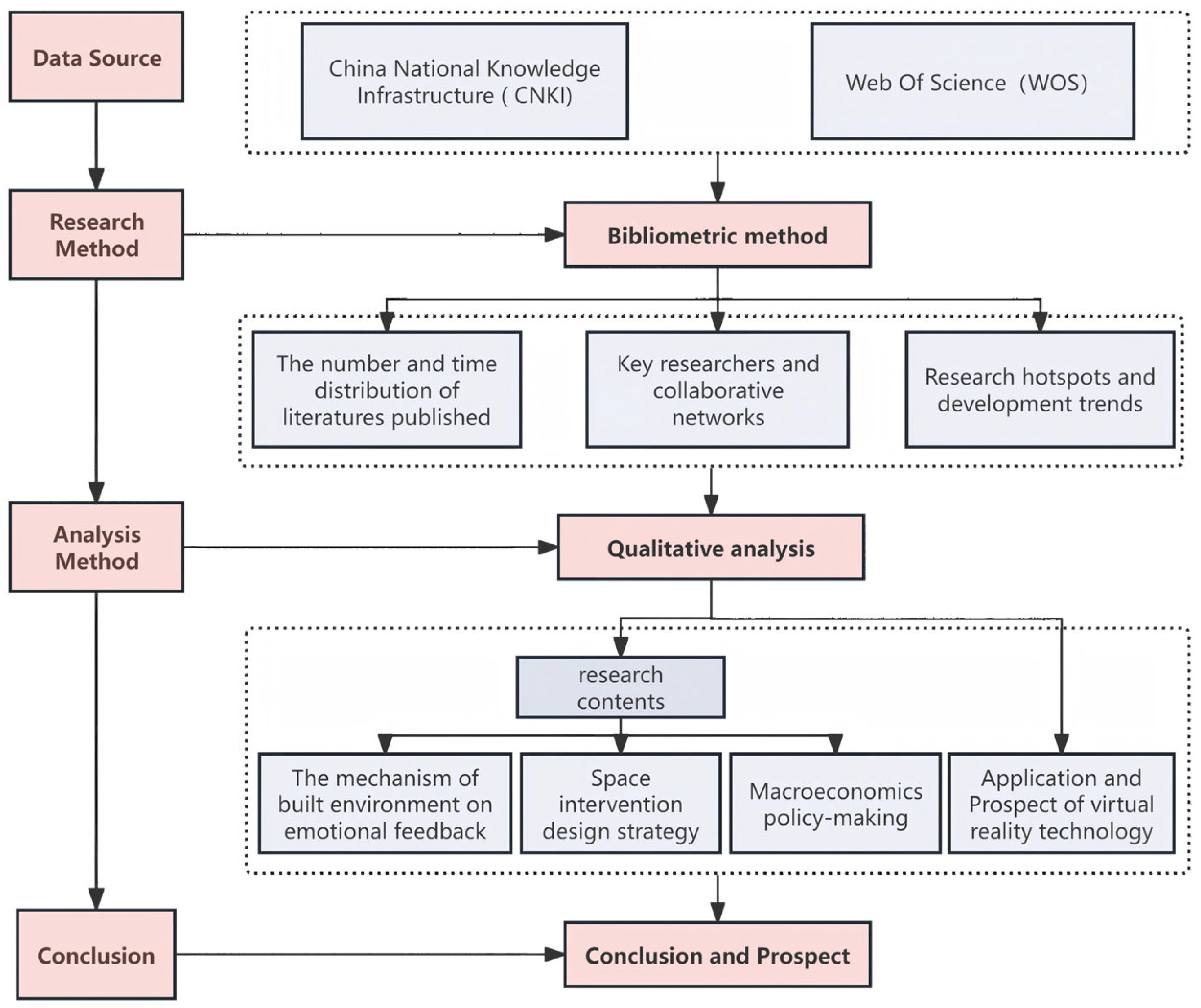

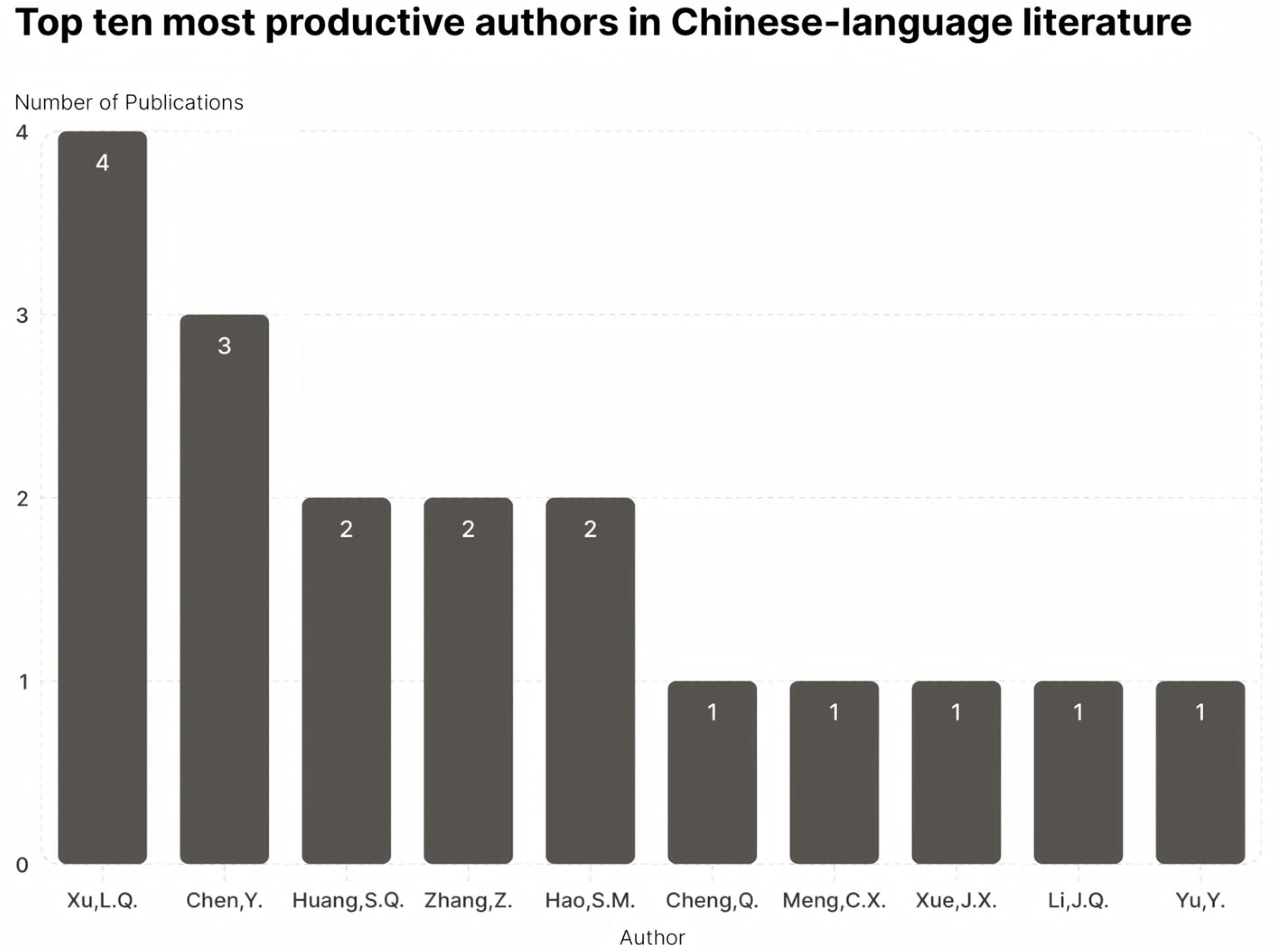
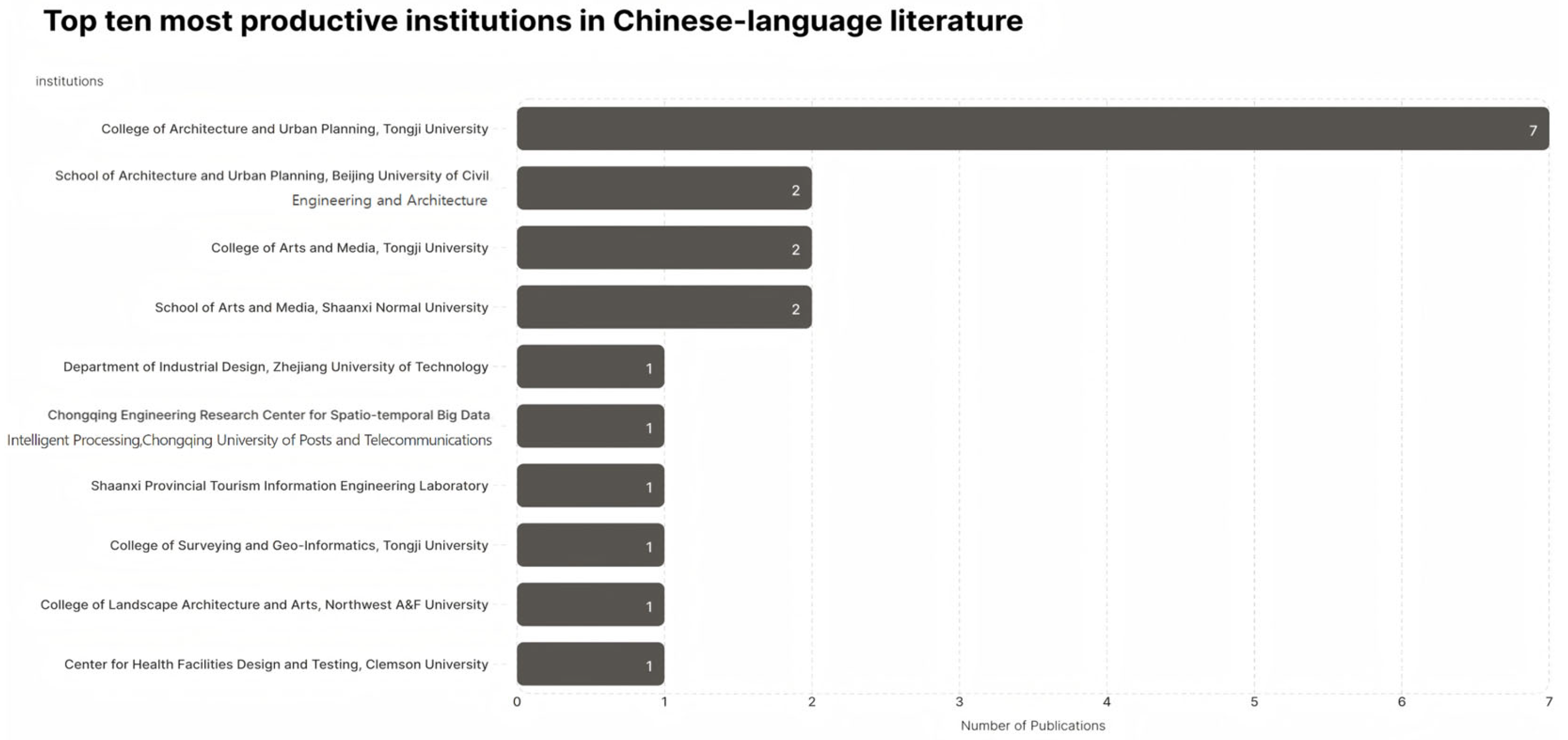
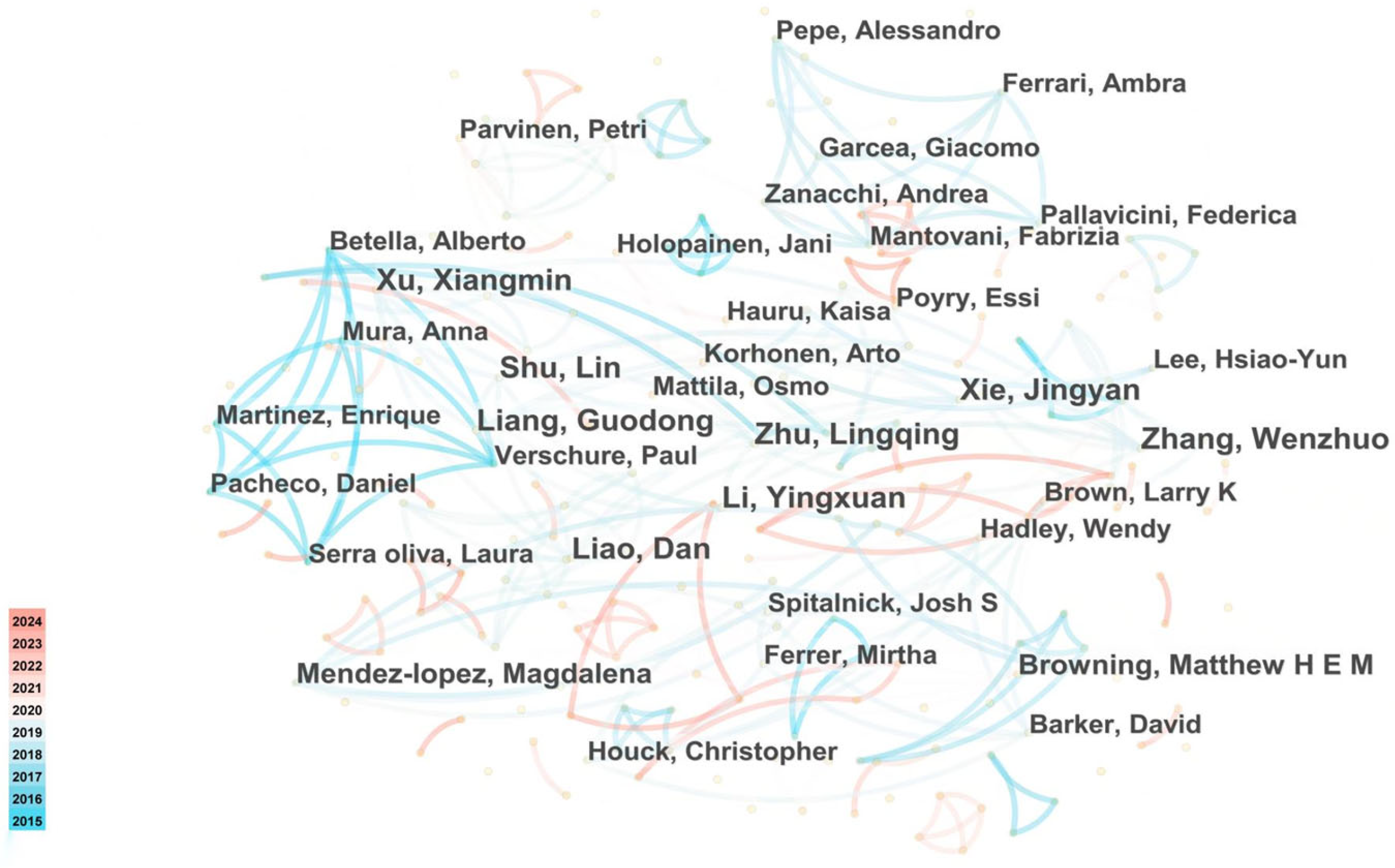

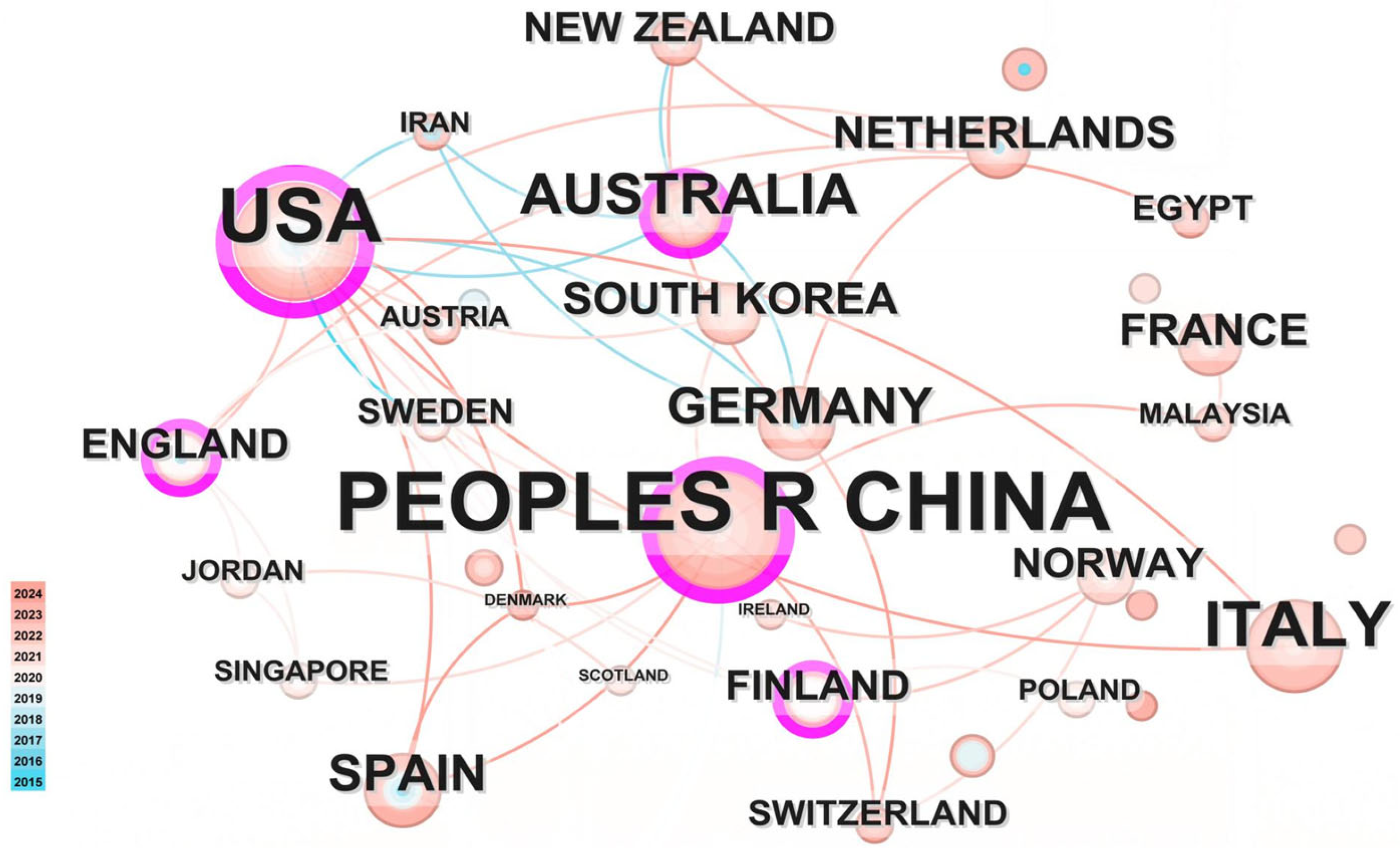
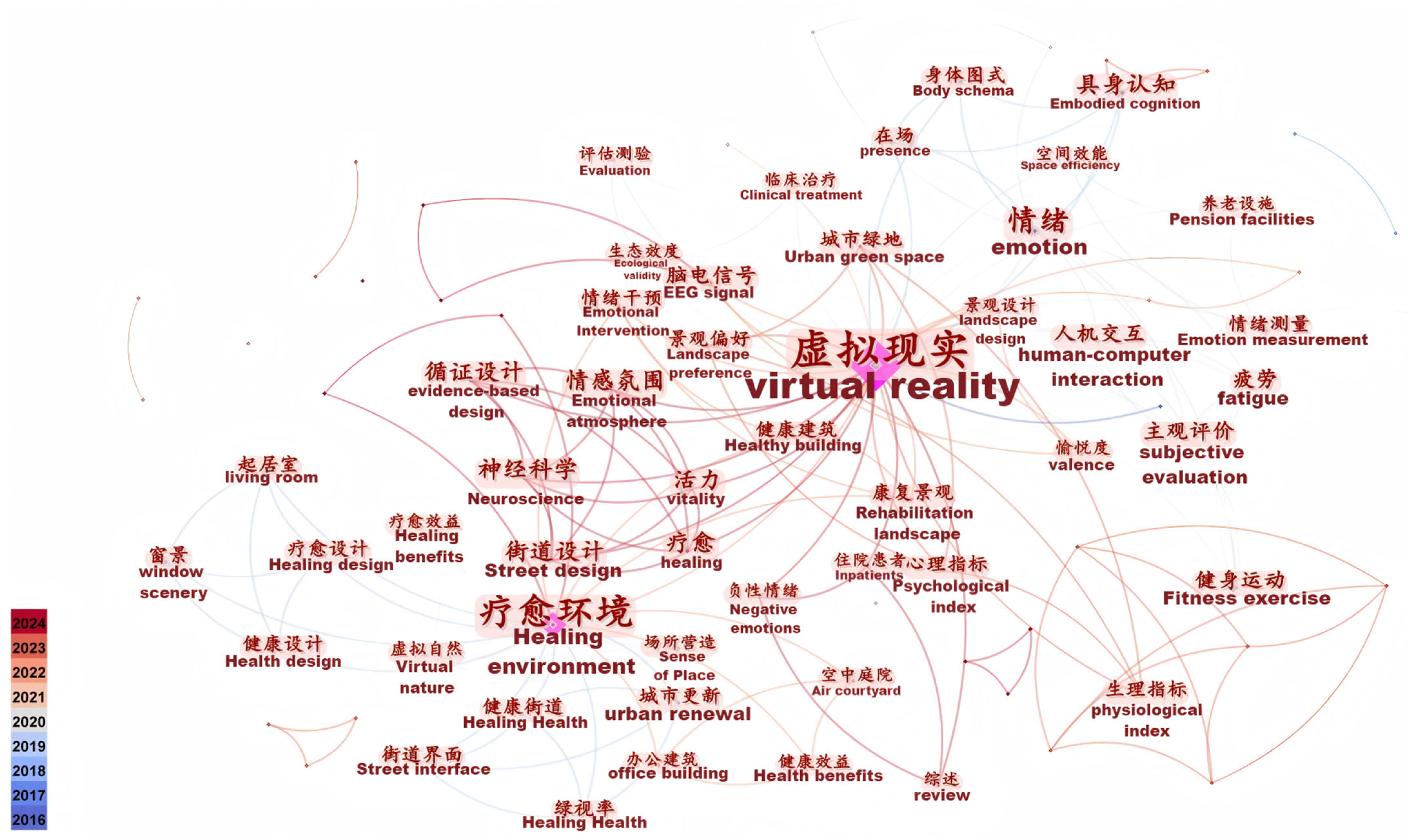
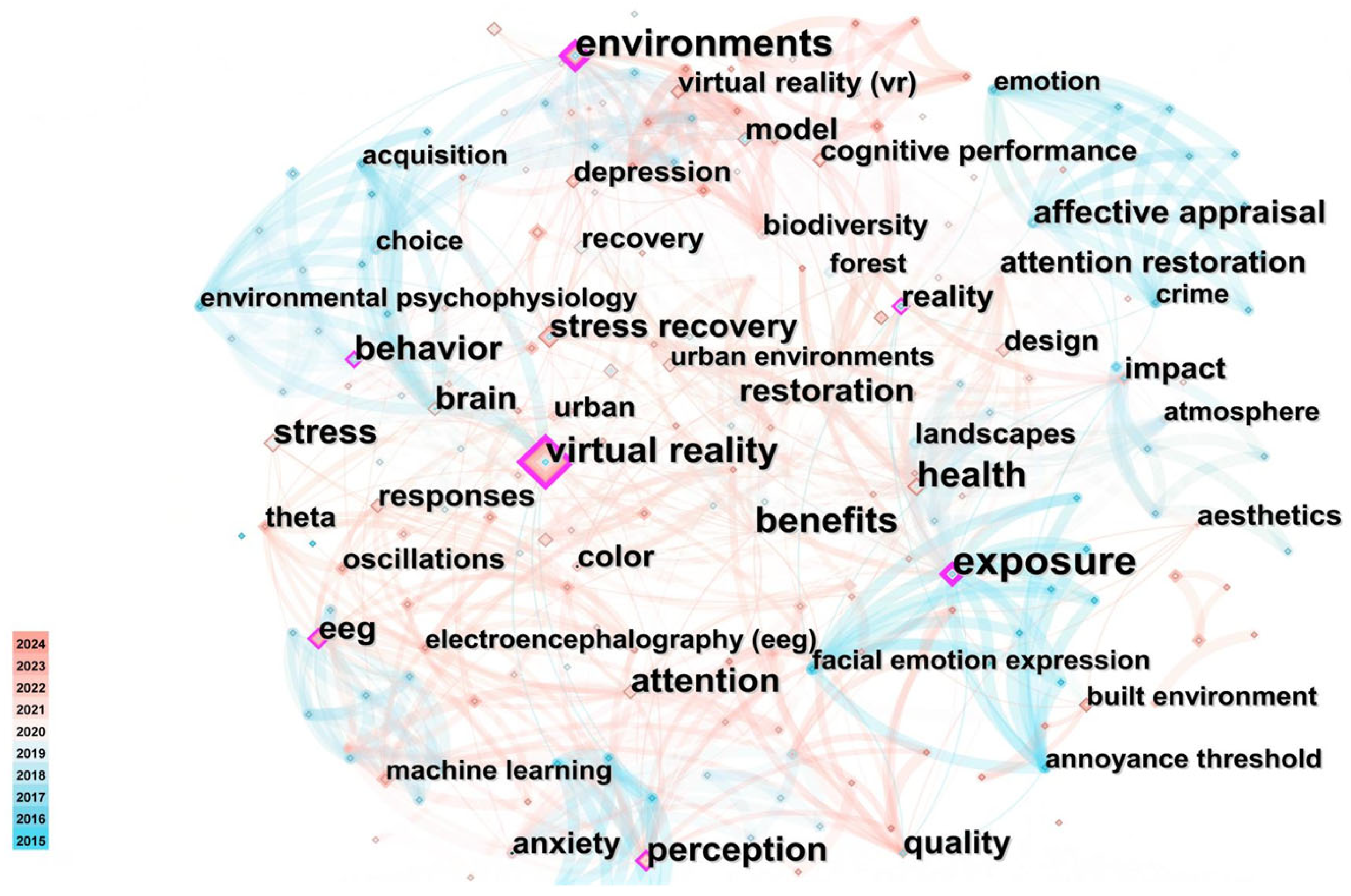
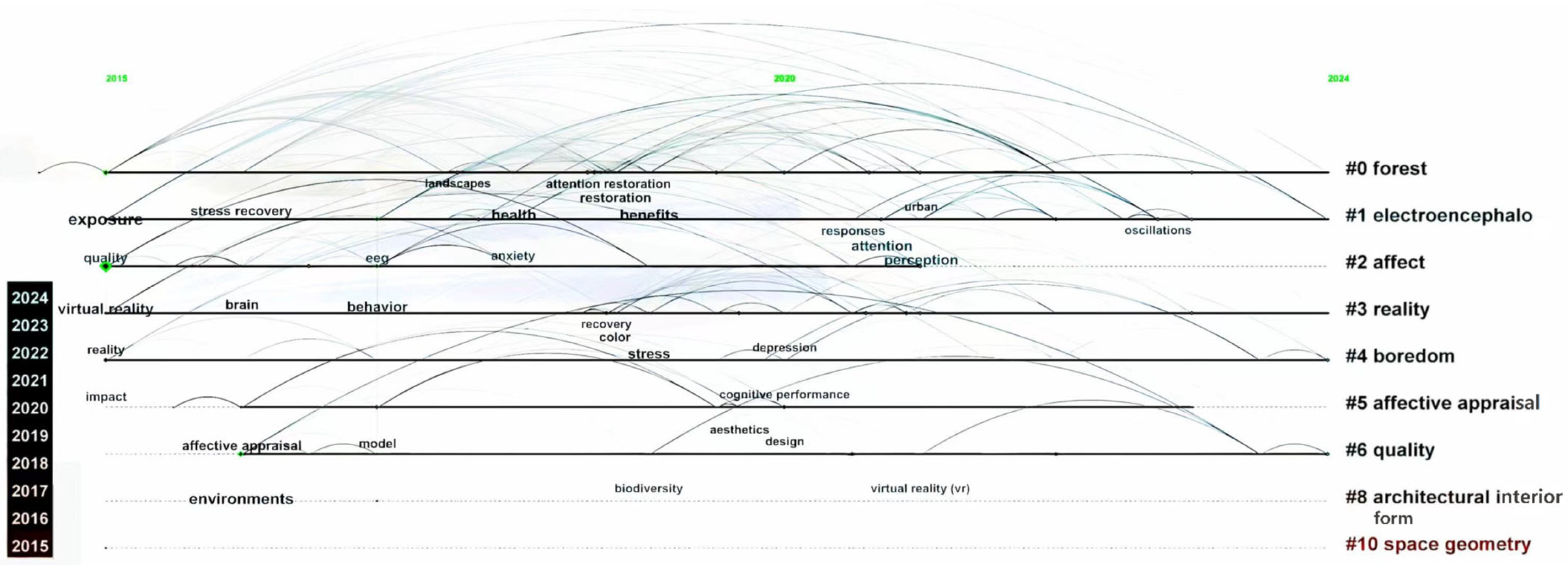

| Rank | Publications | Centrality | Country |
|---|---|---|---|
| 1 | 26 | 0.29 | China |
| 2 | 19 | 0.57 | USA |
| 3 | 11 | 0.00 | Italy |
| 4 | 10 | 0.10 | Australia |
| 5 | 6 | 0.07 | Germany |
| 6 | 6 | 0.00 | Spain |
| 7 | 5 | 0.00 | France |
| 8 | 5 | 0.00 | South Korea |
| 9 | 5 | 0.04 | Netherlands |
| 10 | 4 | 0.13 | UK |
| Rank | Frequency | Centrality | Keyword |
|---|---|---|---|
| 1 | 57 | 0.24 | virtual reality |
| 2 | 17 | 0.21 | exposure |
| 3 | 16 | 0.05 | stress recovery |
| 4 | 14 | 0.23 | environments |
| 5 | 12 | 0.08 | health |
| 6 | 11 | 0.08 | benefits |
| 7 | 11 | 0.11 | perception |
| 8 | 9 | 0.15 | behavior |
| 9 | 8 | 0.09 | stress |
| 10 | 8 | 0.06 | model |
| Aspect | Chinese-Language Literature | English-Language Literature |
|---|---|---|
| General Trend | Demonstrates rapid growth in recent years and has emerged as a new research hotspot. | Entered the field earlier and maintains a clear numerical advantage in publication volume. |
| Both bodies of literature reflect a significant rise in scholarly interest in this topic. | ||
| Collaboration Networks | Characterized by tightly-knit collaboration, primarily among domestic universities and research institutes. | Features more geographically dispersed international collaborations, although with a relatively looser structure. |
| Core research groups are identifiable in both contexts. | ||
| Research Hotspots | Emphasizes technological applications (e.g., EEG, eye-tracking) and the design of healing environments. | Focuses more on stress recovery public health evaluation, and broader scenario-based applications. |
| Both emphasize the role of VR in understanding pedestrian emotion and its urban applications. | ||
| Application Area | Mechanistic Pathway | VR Application and Methods | Typical Case |
|---|---|---|---|
| Mental health intervention | Restorative environmental stimuli activate the parasympathetic nervous system [36]. | Restorative environments built on the Unity engine, enabling human–computer interaction design. | Wang Zhimeng et al. (2022) developed a virtual park in Unity for individuals with mild-to-moderate depression, reducing SDS scores (p = 0.017); watering activity reduced depression by 21% (p = 0.013) [37]. |
| Physical health promotion | Reduction of stress hormone levels [38]. | Construction of contrast scenes with environmental parameter control and real-time physiological monitoring. | Salgado-Pineda P. et al. (2023) found that a beach VR scene reduced systolic blood pressure by 12 mmHg, outperforming urban scenes (Δ = 7.2 mmHg, p < 0.05) [39]. |
| Cognitive resource optimization | Reduction of prefrontal cortex cognitive load [40]. | Multivariate orthogonal experiments integrating eye-tracking and neural activity monitoring. | Zhang Yalin (2024) showed that when the window-to-wall ratio in classrooms was 30%, Stroop test error rates decreased by 21%, and sustained attention increased by 43% [41]. |
| Commercial value enhancement | Increased emotional appeal of environments [42]. | Spatial experience simulation with user behavior heatmapping and decision path analysis. | Maurizio Mauri (2024) found that VR-based property viewing shortened decision time by 58% and increased transaction rates by 33% [43]. |
| Cultural identity building | Activation of collective memory and emotional resonance [44]. | Reconstruction of 3D scenes integrated with emotional semantics and spatial optimization validation. | In the Shanghai Gongkang Road micro-renewal project, VR-based emotional mapping raised residents’ place identity scores from 2.8/5 to 4.1/5 (Zhang Zhen et al., 2024) [45]. |
| Support for special populations | Customized sensory–cognitive matching strategies [46]. | Closed-loop neurofeedback monitoring with longitudinal intervention assessment. | Abu Hasan et al. (2022) developed an EEG–VR training system for preschool educators, improving psychological resilience scores by 29% and reducing occupational burnout incidence by 41% [27]. |
Disclaimer/Publisher’s Note: The statements, opinions and data contained in all publications are solely those of the individual author(s) and contributor(s) and not of MDPI and/or the editor(s). MDPI and/or the editor(s) disclaim responsibility for any injury to people or property resulting from any ideas, methods, instructions or products referred to in the content. |
© 2025 by the authors. Licensee MDPI, Basel, Switzerland. This article is an open access article distributed under the terms and conditions of the Creative Commons Attribution (CC BY) license (https://creativecommons.org/licenses/by/4.0/).
Share and Cite
Wang, Y.; Wang, Y.; Li, X.; Guan, X.; Zhang, B.; Huang, X. Pedestrian Emotion Perception in Urban Built Environments Based on Virtual Reality Technology: A Comparative Review of Chinese- and English-Language Literature. Buildings 2025, 15, 3713. https://doi.org/10.3390/buildings15203713
Wang Y, Wang Y, Li X, Guan X, Zhang B, Huang X. Pedestrian Emotion Perception in Urban Built Environments Based on Virtual Reality Technology: A Comparative Review of Chinese- and English-Language Literature. Buildings. 2025; 15(20):3713. https://doi.org/10.3390/buildings15203713
Chicago/Turabian StyleWang, Yidan, Yan Wang, Xiang Li, Xuenan Guan, Bo Zhang, and Xiaoran Huang. 2025. "Pedestrian Emotion Perception in Urban Built Environments Based on Virtual Reality Technology: A Comparative Review of Chinese- and English-Language Literature" Buildings 15, no. 20: 3713. https://doi.org/10.3390/buildings15203713
APA StyleWang, Y., Wang, Y., Li, X., Guan, X., Zhang, B., & Huang, X. (2025). Pedestrian Emotion Perception in Urban Built Environments Based on Virtual Reality Technology: A Comparative Review of Chinese- and English-Language Literature. Buildings, 15(20), 3713. https://doi.org/10.3390/buildings15203713






